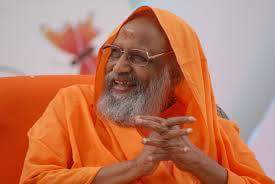Question : But we keep hearing that there are teachers
who, through touch, can cause all things to fall into place so that you realize
the Truth. Could it be that through experiences you can get enough glimpses of
the vision of Truth so that you then won’t have to go through the heavy
intellectual resistance to accepting that vision? Does it boil down to clearing
the intellect?
Swamiji : No. The
Truth of oneself is not an intellectual conclusion, nor is it something to be
‘reached’ by experiences. The Guru is
not an elevator who touches you and you go ‘up to Brahman.’ Brahman is you --
not a place to be reached. It is not through an experience that you become
Truth. There is nothing to become. There is nothing to transform. You are the
Truth that you are seeking. The teaching of Vedanta is simply a means of knowledge (praman), and an instrument that shows you what you are.
What you are is not an intellectual conclusion. An
intellectual conclusion is an inferential conclusion about something that is
not available for immediate perception but about which there are data available
from which logical conclusions can be reached. You need not be inferred because
you are right here with yourself; you are immediately present. You are
available to be known, not to be inferred. You fail to know yourself only due
to ignorance, not due to lack of availability. Knowledge, not inference, and
not experience, destroys that ignorance.
Vedanta directly teaches what you
are. The use of logic is for the removal of doubts to give clarity to your
vision. We use certain reasoning methods (yukti)
to remove the blocks you may have that interfere with your clear vision. These
blocks are always rational and can be removed by reason. We use your
experiences also. We help you assimilate your experiences in terms of
knowledge. In fact, we help you see that you have always had the experience of
yourself. You don’t require a new experience to see yourself. There is no
source of the vision of fullness (ananda)
that you call happiness, except yourself.
Whenever, at any time,
you pick up a resolving moment of happiness, you experience your essential
self. Vishayaananda means happiness
gained through a desirable object—something in which there is a ‘kick’ for you
and for a moment that ‘kick’ swallows up all the other wants of the wanting
mind. That fullness (aananda) that,
happiness (sukha) is but yourself, really. Through some gain, through some
sensation, through a profound appreciation of beauty, a certain mental
condition occurs in which, for the moment, you are just with yourself—you do
not want a change in anything whatsoever. In the quiet clarity of a mind that
wants no change, you pick up yourself as a moment of happiness. You do not
recognize that happiness as yourself
and instead attribute it to an object or a situation experienced.
Desiring happiness all
the time, you continually seek it through all your actions. You know that you
want happiness again. The very fact that you want happiness shows that you know
it. Nobody desires something that is unknown. What you do not know is that you are happiness; you cannot help but seek
it because it is your very nature and you cannot settle for anything else or
anything less. You do know that there are moments of fullness which are moments
of happiness. You do not require some strange, new experience to know that.
Even if you gain some
new experience that reveals happiness to you, it makes no difference. Whether
the experiences you have are usual or unusual, they still have to be
assimilated in terms of knowledge. Experience itself does not give knowledge.
It is only experience. It come and goes. Shruti,
the scriptures, particularly the Upanishads,
provide the basis for the knowledge that the moments of happiness I experience
reflect my real nature, which is limitless fullness. Shruti, is the means of knowledge, for what one cannot account for
through perception-based data.
Not only that
experience does not give me the knowledge of the nature of fullness, but also
experience does not give me the vision of the whole. Slipping into myself does
not give me knowledge of the whole—knowledge of the Truth of me, of the world
and of the creator. It is the knowledge of the whole that frees me just as I
am. For that knowledge I need to know, very well, what is apparently real (mithya), and what is limitless reality (satyam). It is not enough just to be
myself—I have to account for this world or things will not fall into place. If
I do not discover the nature of the world as well as the nature of myself, the
world will overwhelm me and I will have to escape the world.
Vedanta has been presented as an
experience. This has been a wrong presentation. Vedanta is knowledge, not a happening. A teacher unfolds the
knowledge of oneself until it is clear. Doubts and vagueness are eliminated by
logic bringing clarity of vision.
Vedanta is immediacy of
knowledge. When that immediacy of knowledge is presented as experience,
confusion follows. This confusion has arisen, at least in part, because of a
word in Sanskrit, ‘anubhava’, which
has been translated in English simply as ‘experience’. Such a translation
causes the expectation of a ‘happening,’ not a ‘seeing.’ I would rather
translate ‘anubhava’ as ‘immediate
knowledge’. For the qualified student that which comes after teaching is
knowledge in keeping with the teaching, and that is anubhava.
Om Tat Sat





